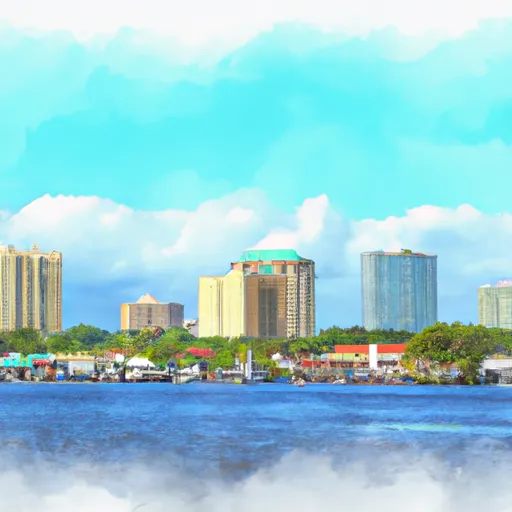-
 Snoflo Premium
Snoflo Premium
Get unlimited access to all our content
With no Ad interruptions! - Start Your Free Trial Login with existing account
Safety-Harbor
Eden Index
Climate
6.6
•
Recreation
4.2
•
Community
3.6
•
Safeguard
5.0/10

Safety Harbor is a charming town located on the western coast of Florida, known for its pleasant climate, beautiful hydrology constituents, and ample outdoor recreation opportunities. The city experiences a warm and humid subtropical climate, with hot and humid summers and mild winters. Average temperatures range from the mid-70s°F (24°C) in winter to the mid-90s°F (35°C) in summer, making it a favored destination for those seeking a year-round comfortable climate.
Safety Harbor is surrounded by stunning hydrological elements, including Tampa Bay and Old Tampa Bay. These pristine bodies of water offer abundant opportunities for water sports such as boating, fishing, and kayaking. The area is also known for its natural springs, with several nearby parks providing access to these refreshing and picturesque sites.
Outdoor enthusiasts can enjoy the various parks and recreational areas in and around Safety Harbor. Philippe Park, located on the shores of Old Tampa Bay, offers hiking trails, picnic spots, and historical sites. The Safety Harbor Marina Park provides a boat launch, fishing pier, and a waterfront boardwalk. The city also boasts a number of biking and walking trails, perfect for exploring the scenic beauty of the area.
In conclusion, Safety Harbor, Florida, with its pleasant climate, stunning hydrological features, and diverse outdoor opportunities, is a perfect destination for those seeking an active and enjoyable outdoor lifestyle.
What is the Eden Index?
The Snoflo Eden Index serves as a comprehensive rating system for regions, evaluating their desirability through a holistic assessment of climate health, outdoor recreation opportunities, and natural disaster risk, acknowledging the profound impact of these factors on livability and well-being.
Climate Health Indicator (CHI): 6.6
Safety-Harbor receives approximately
1325mm of rain per year,
with humidity levels near 86%
and air temperatures averaging around
23°C.
Safety-Harbor has a plant hardyness factor of
10, meaning
plants and agriculture in this region tend to thrive here all year round.
By considering the ideal temperature range, reliable water supplies, clean air, and stable seasonal rain or snowpacks, the Climate Health Indicator (CHI) underscores the significance of a healthy climate as the foundation for quality living.
A healthy climate is paramount for ensuring a high quality of life and livability in a region, fostering both physical well-being and environmental harmony. This can be characterized by ideal temperatures, reliable access to water supplies, clean air, and consistent seasonal rain or snowpacks.
Weather Forecast
Streamflow Conditions
Tampa Bay
Area Rivers
Tampa Bay
Snowpack Depths
Tampa Bay
Reservoir Storage Capacity
Tampa Bay
Groundwater Levels
Recreational Opportunity Index (ROI): 4.2
The Recreational Opportunity Index (ROI) recognizes the value of outdoor recreational options, such as parks, hiking trails, camping sites, and fishing spots, while acknowledging that climate plays a pivotal role in ensuring the comfort and consistency of these experiences.
Access to outdoor recreational opportunities, encompassing activities such as parks, hiking, camping, and fishing, is crucial for overall well-being, and the climate plays a pivotal role in enabling and enhancing these experiences, ensuring that individuals can engage in nature-based activities comfortably and consistently.
Camping Areas
| Campground | Campsites | Reservations | Toilets | Showers | Elevation |
|---|---|---|---|---|---|
| Raccoon Creek Military - MacDill AFB | None | 5 ft | |||
| Coons Creek Military - MacDill AFB | None | 5 ft | |||
| Fort Desoto County Park | 238 | 3 ft |
Catastrophe Safeguard Index (CSI):
The Catastrophe Safeguard Index (CSI) recognizes that natural disaster risk, encompassing floods, fires, hurricanes, and tornadoes, can drastically affect safety and the overall appeal of an area.
The level of natural disaster risk in a region significantly affects safety and the overall livability, with climate change amplifying these risks by potentially increasing the frequency and intensity of events like floods, fires, hurricanes, and tornadoes, thereby posing substantial challenges to community resilience and well-being.
Community Resilience Indicator (CRI): 3.6
The Community Resilience Indicator (CRI) recognizes that education, healthcare, and socioeconomics are crucial to the well-being of a region. The CRI acknowledges the profound impact of these elements on residents' overall quality of life. By evaluating educational resources, healthcare accessibility, and economic inclusivity, the index captures the essential aspects that contribute to a thriving community, fostering resident satisfaction, equity, and social cohesion.

